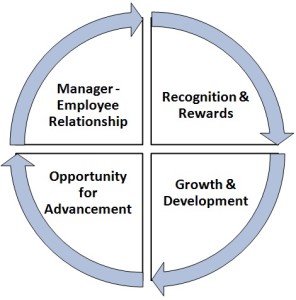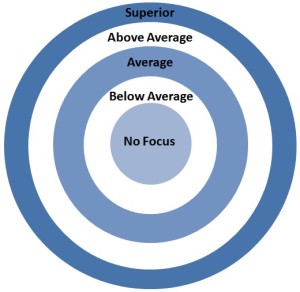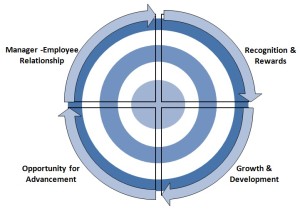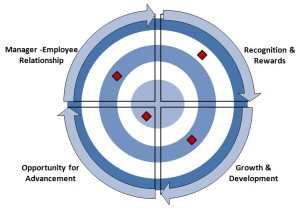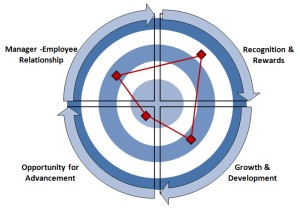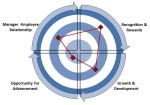 On January 28, 2015, Amy Adkins of Gallup published an article entitled, Majority of U.S. Employees Not Engaged Despite Gains in 2014. “Less than one-third (31.5%) of U.S. workers were engaged in their jobs in 2014. The average is up nearly two percentage points from 29.6% in 2013 and represents the highest reading since 2000, when Gallup first began tracking the engagement levels of the U.S. working population. However, a majority of employees, 51%, were still “not engaged” and 17.5% were “actively disengaged” in 2014.”1
On January 28, 2015, Amy Adkins of Gallup published an article entitled, Majority of U.S. Employees Not Engaged Despite Gains in 2014. “Less than one-third (31.5%) of U.S. workers were engaged in their jobs in 2014. The average is up nearly two percentage points from 29.6% in 2013 and represents the highest reading since 2000, when Gallup first began tracking the engagement levels of the U.S. working population. However, a majority of employees, 51%, were still “not engaged” and 17.5% were “actively disengaged” in 2014.”1
While a slight improvement is good, there is much more to be done. Employee engagement needs to be part of everyone’s, i.e. individual employees, managers, leadership, and the company’s, daily priorities to the point that it becomes part of the normal routine. By routine, I mean that everyone understands and focuses on the most important factors impacting employee engagement.
While there are plenty of places to begin, it would be most helpful to know what your employees think. First, determine what information is currently available. This could include the results of previous employee engagement surveys and/or exit interview statistics. Evaluate these sources to understand where your company as a whole needs to improve. If you are a manager, review your individual engagement results and comments.
If there is no survey information, a second approach would be to consult with your direct reports, managers, and those in Human Resources. There can be many possibilities and by digging a little deeper, you will be able to compile a small group of the most relevant causes of disengagement within your organization. Even as an employee, you have a responsibility to finds ways to better engage yourself. What would make you more productive, etc.?
Below is an example of what you may find. Based on my reading, these four areas account for much of the disengagement. These may or may not be relevant to your situation.
Manager – Employee Relationship
Rewards and Recognition
Growth and Development
Opportunity for Advancement
Whatever areas you uncover, place them on a “Wheel of Life.” 2 A Wheel of Life is a tool that is meant to help one analyze all the areas of their life and help access where more attention is needed. By applying this concept to the areas you identified above, we can establish the Wheel of Employee Engagement. Below is an example.
Having learned some of the reasons behind disengagement, it is time to choose a simple way to evaluate your performance or progress as it relates to each area. You could use a number scale (1=poor to 5=outstanding) or rate yourself from “No Focus” to “Superior” as the chart below represents. The scale you choose is not important as long as it can be applied equally to each area you identified.
Let’s combine these two graphics to complete our Wheel of Employee Engagement.
Now, it is time to assess how well you are doing in each of those areas. Think carefully about the impact you make in each area. Remember; use the information you collected to help in this determination. Keep in mind that engagement is not a one-size-fits-all approach. “[F]actors such as age, generation, gender, education level and tenure all relate to a worker’s engagement, as do an employee’s job category and industry.” 3
Given your current situation as an employee, leader, or company, how would you rate yourself? How would your employees and/or coworkers rate you? Using the Wheel of Employee Engagement, place a mark where the area and your rating of yourself intersect. Below is an example.
The final step in the process is to connect those marks to form a spidergram. A spidergram is “a diagram (= simple plan) with lines and circles for organizing information so that it is easier to use or remember.” 4 Below is an example.
Now what? Using your completed Wheel of Employee Engagement, you will be able to identify where improvement is needed. A good rule of thumb is to work to align all areas along the same rating. Start with a goal of getting all areas to “Average” and then begin to work your way outward toward your top measure.
Stay tuned. The next set of posts will focus on ways to improve each of the 4 areas:
The Wheel of Employee Engagement: Manager – Employee Relationship
The Wheel of Employee Engagement: Recognition and Rewards
The Wheel of Employee Engagement: Growth and Development
The Wheel of Employee Engagement: Opportunity for Advancement
What do you think about the Wheel of Employee Engagement? In what ways to you evaluate your path to better engaging your employees or your own engagement.
1 Adkins, Amy. “Majority of U.S. Employees Not Engaged Despite Gains in 2014.” Majority of U.S. Employees Not Engaged Despite Gains in 2014. Gallup, Inc., 28 Jan. 2015. Web. 3 Feb. 2015. <http://www.gallup.com/poll/181289/majority-employees-not-engaged-despite-gains-2014.aspx?utm_source=EMPLOYEE_ENGAGEMENT&utm_medium=topic&utm_campaign=tiles>.
2 “Wheel of Life” is a trademark of Meyer Resource Group, Inc. “Success Motivation” is a trademark of Success Motivation, Inc. (see www.success-motivation.com).
3 Robison, Jennifer. “Different Demographic Groups Must Be Managed Differently.” Different Demographic Groups Must Be Managed Differently. Gallup, Inc., 20 Jan. 2015. Web. 3 Feb. 2015. <http://www.gallup.com/businessjournal/181205/different-demographic-groups-managed-differently.aspx?utm_source=EMPLOYEE_ENGAGEMENT&utm_medium=topic&utm_campaign=tiles>.
4 “Cambridge Dictionaries Online.” Spidergram. Web. 3 Feb. 2015. <http://dictionary.cambridge.org/us/dictionary/british/spidergram>.
Let’s Engage!
I’m Agent in Engagement Simpson…Gregory F Simpson.
I’m excited about this opportunity to connect with fellow “Agents.” Subscribe to the RSS Feed to receive the latest updates and/or register to comment on posts.
 You can follow me @agtinengagement.
You can follow me @agtinengagement.
Email me at g…@a…t.com.
Learn more about me at www.gregoryfsimpson.com.
P.S. First time here? Welcome to the Agent In Engagement site. Thanks for taking the time to stop by! I hope you’ll explore the rest of the site. Let me know what employee engagement topics interest you.
Other recent Agent in Engagement articles by Gregory F Simpson:
- Employee Engagement Briefing for Week of January 26 – 30, 2015
- Employee Engagement Quotes from January 19 – 22, 2015
- Continuing to Engage Through The Infographic
- Top Employee Engagement Infographics of 2014
- The Favorite Employee Engagement Books I Read In 2014
- Most Viewed Agent In Engagement Posts 2014

